What started as a small papal collection of sculptures has, over the centuries, transformed into a museum complex featuring one of the finest collections of art on the planet. The interior decoration of the palaces that house the collection is just as amazing.
History of the Museums
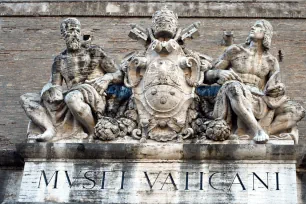
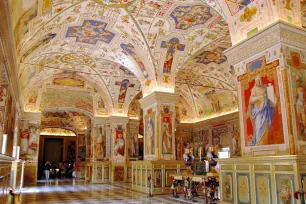
The Vatican Museums were founded under the patronage of two eighteenth-century popes – Clement XIV (1769-1774) and Pius VI (1775-1799) – who were among the first to open collections of art to the general public for viewing, therefore promoting culture among the masses. Appropriately, the first building in the museum complex, the Pio-Clementine Museum, was named after these two pontiffs.
The origin of the museums’ collection goes back much further. It all started in 1480 with the discovery of a Roman statue, ‘The Apollo of Belvedere’, still one of the highlights of the Vatican Museums. In 1503 Julius II had the statue placed in the Cortile Ottagono, an octagonal courtyard.
As the decades passed, more popes added to the amazing collection of diverse artworks owned and displayed by the Vatican. Today, there are thirteen museums in a huge architectural complex comprising of two Vatican palaces.
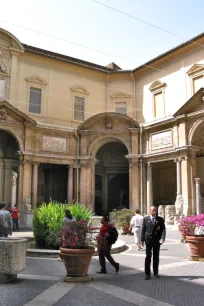
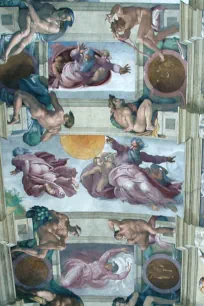
The building complex is worth a visit in itself as all the rooms and hallways are lavishly decorated with marble and frescoes.
The Museums and Collections
It’s best not to try and see everything in one visit – the whole route along all the museums is seven kilometers long (4.4 miles) – but focus on a number of highlights or museums you want to see. And make sure you have some time and energy left over for the Raphael Rooms and the Sistine Chapel, which are located towards the end of the museum.
To keep the massive crowds under control, the museum has four color-coded itineraries that range from one and a half hours to more than five hours. All itineraries end in the Sistine Chapel.
Classical Antiquities
One of the Vatican Museums’ main strengths is the collection of ancient Roman and Greek art, which is spread over four museums. Some of the most famous statues, including the Laocoön and the Apollo del Belvedere can be found here.
Pio-Clementine Museum
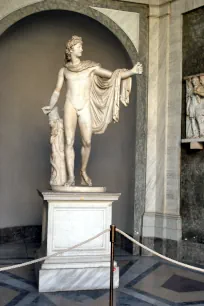
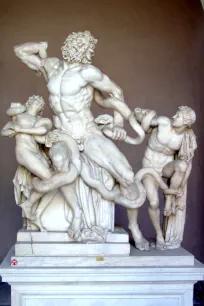
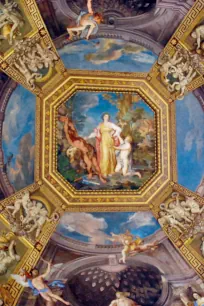
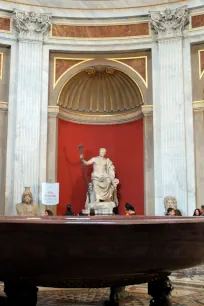
The Pio-Clementine Museum (Museo Pio—Clementino) forms the core of the Vatican Museums. Most of the collection consists of statues discovered in and around Rome.
Among the many highlights is the so-called Apoxyomenos (the Scraper), a 1st century marble copy of a famous bronze statue by Lysippos. The statue was discovered in 1849 in Trastevere. It depicts an athlete scraping the sweat of his body. The fig leaf was added later (Romans and Greek never censored their artwork).
The Octagon Court (Cortile Ottagonale), the oldest part of the Vatican Museums, contains several masterpieces. Among them the Apollo of Belvedere, another Roman copy of a Greek original by Leochares. The statue of the god Apollo stretching out his arm has been described as the perfection of aesthetics.
But even more famous is the Laocoön, a sculpture group discovered in 1506 on the Esquiline Hill. The group was created in around 30 BC by three sculptors from Rhodes who probably copied an original from the 2nd century BC. It depicts the Trojan priest Laocoön and his two sons being strangled by serpents. According to a story by the Roman poet Virgil, Laocoön warned the Trojans not to bring the wooden horse into Troy so the goddess Athena sent two serpents out to kill the priest. The sculpture group is acclaimed for its dignified portrayal of agony.
The Hall of the Muses (Sala delle Muse) is decorated with frescoes of Apollo and the Muses, created in the late eighteenth century by Tommaso Conca. The centerpiece here is the Belvedere Torso. The statue was found in the Campo de’ Fiori and is signed by Apollonius of Athens, a Greek sculptor of the first century BC. Unfortunately the legs and arms are missing but the torso is considered a perfect example of male anatomy. The torso inspired Michelangelo for his nudes on the ceiling of the Sistine Chapel.
The adjoining Round Room (Sala Rotonda) is modeled after the Pantheon. The floor is paved with a magnificent Roman mosaic from the second or early third century AD that depicts various sea monsters and other mythological figures. The floor was discovered in Otricoli, a small town in Umbria. From the same site comes the Otricoli Zeus, a copy of a bust by the Greek sculptor Bryaxis from the fourth century BC. In the middle of the room is a large porphyry basin – the so-called ‘bathtub of Nero’ – that was found in Nero’s Golden House. The niches surrounding the rooms hold a variety of statues. The most impressive is the colossal statue of Hercules in gilt bronze from the 2nd century AD.
Other interesting rooms of the Pio-Clementine Museum include the Gallery of Statues, with a sensual sculpture of a Sleeping Ariadne that was a favorite inspiration for many neoclassical sculptors. The Room of the Animals has an excellent collection of animal statues and mosaics, and the Cabinet of the Masks is named for the mosaics of masks that were integrated in the floor and come from Hadrian’s Villa in Tivoli. The Greek Cross Room holds the sarcophagi of Helen (the mother of Emperor Constantine) and her granddaughter Constantina.
Chiaramonti Museum & the New Wing
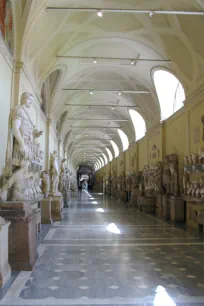
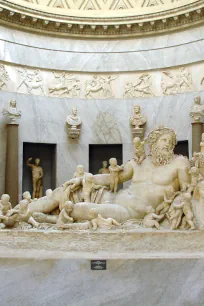
The Museo Chiaramonti is named after its founder Pius VII, who was born Luigi Barnaba Chiaramonti. The museum occupies part of the three-hundred meter-long (about 1,000 ft.) wing that was built in 1807 after a design by Bramante. It holds a massive amount of statuary, including many busts that were used by the Romans as ancestral portraits.
The rest of the gallery is home to the lapidary (Galleria Lapidaria), with a large epigraphic collection that contains more than four thousand inscriptions. Unfortunately this department is closed except by special permission.
The Chiaramonti gallery is followed by the New Wing (Braccio Nuovo), which boasts a magnificent floor made of Roman mosaics. Here you find more Roman statues, including the Augustus of Prima Porta that portrays the Roman Emperor Augustus. The statue was discovered in 1863 at the villa of Livia Augusta.
Another highlight is the colossal personification of the Nile. It shows the river god lying on his side and leaning on a sphinx. At his foot is a crocodile and the god holds a bushel of wheat in his hand, symbol of the fertile ground of the Nile valley that was a result of the river’s regular flooding. It is thought that the sixteen infants who crawl over him are a reference to the ideal height of sixteen cubits to which the Nile river had to rise to guarantee fertile soil.
Gregorian Etruscan Museum
The Etruscan Museum (Museo Gregoriano Etrusco) was founded by Pope Gregory XVI in 1837. It is one of the most important museums of its kind although it is now eclipsed by the National Etruscan Museum in Villa Borghese that was founded after the unification of Italy.
The Etruscan Museum of the Vatican has a particularly fine collection of vases, which show the influence of Greek techniques and decorations on the Etruscans. A notable example is an amphora decorated with the figures of Achilles and Ajax playing dice. Another highlight of the collection is a series of objects found in the Regolini-Galassi tomb at Cerveteri, among them a wooden throne and a carriage from the seventh century BC. The most significant statue is the Mars of Todi, a bronze statue from the fifth century BC.
Gregorian Museum of Pagan Antiquities
The Gregorian Museum of Pagan Antiquities (Museo Gregoriano Profano) is another museum with Roman and Greek statuary. The museum was established in 1884 by Gregory XVI and contains statues, sarcophagi, reliefs and funerary monuments, most of which date back to the Imperial age (1st and 2nd century AD). The most famous work here is Athena and Marsyas, a copy of the bronze original from the fifth century BC by the Greek sculptor Myron. There are also mosaics of athletes from the Baths of Caracalla and fragments from the Parthenon on display.
Gregorian Egyptian Museum
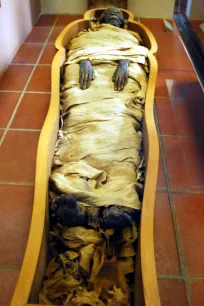
The Gregorian Egyptian Museum (Museo Gregoriano Egizio) is another museum founded by Pope Gregory XVI, who had a keen interest in Egypt. Featuring nine rooms, objects d’art in this museum range from stelae and hieroglyphics from around 2500 BC to Roman replicas of Egyptian statues from the second century AD.
Not to miss here is the collection of mummies and mummy cases from around 1000 BC that were found at the Necropolis of Deir el-Bahri in Thebes. One room in the Egyptian museum contains a reconstruction of Canopus from Hadrian’s Villa in Tivoli including the Shrine of Serapis and statues of Egyptian gods.
Vatican Picture Gallery
The Vatican Picture Gallery (Pinacoteca Vaticana) is a relatively new museum. It was founded in the late eighteenth century by Pius VI and opened in 1932. The sixteen rooms of the museum contain paintings that range in age from the twelfth to the nineteenth century. Most of the works are from Italian masters but there are also some foreign artists represented. There’s even a whole room devoted to the Austrian painter Wenzel Peter.
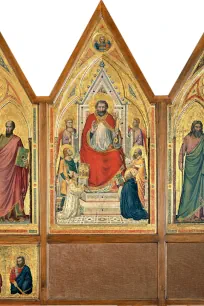
Among the early highlights is the Stefaneschi-triptych that Giotto created around the year 1300 for the old basilica of St. Peter. Another notable work is a fifteenth-century fresco that depicts the founding of the Vatican Library. The painting by Melozzo da Forlì shows the first librarian kneeling before Pope Sixtus IV.
There is also a room dedicated to Raphael which includes the tapestries made by the Flemish artist Pieter van Aelst to cartoons created by Raphael and his students. The tapestries were made to cover the lower walls of the Sistine Chapel. The cartoons are now in the V&A Museum in London. There are also several of Raphael’s paintings in this room, including ‘the Coronation of the Virgin’, which he made when he was only nineteen years old.
Other highlights include Leonardo da Vinci’s unfinished ‘St. Jerome’ (1480), Titian’s ‘Madonna of the Frari’ (1535), Federico Barocci’s ‘Rest on the Flight to Egypt’ (1573) and Caravaggio’s Deposition (1603).
Religious Art
Museum of Modern Religious Art
The Collection of Modern Religious Art (Collezione d’Arte Religiosa Moderna) features fifty-five rooms. It was established in 1973 by behest of Pope Paul VI and is the largest museum of its kind. It contains works from many of the world’s most important modern artists including Dali, Kandinsky, Kokoschka, Le Corbusier, Matisse, Munch, Picasso, Rodin and van Gogh.
Pio Christian Museum
The Pio Christian Museum (Museo Pio Cristiano) holds a collection of sculptures, sarcophagi and mosaics from the early Christian era. The museum was established in 1854 by Pius IX. The most famous object here is the statue of the Good Shepherd, created in the third century AD.
Ethnological Missionary Museum
Founded by Pius XI in 1926, the Ethnological Missionary Museum features objects of a religious nature from four geographical areas – Asia, Oceania, Africa, and America. Many of the 100,000 pieces in the collection were acquired by missionary workers. The museum was originally housed in the Lateran Palace but was relocated here in 1973. Among the highlights are a statue of the god Quetzalcóatl from Mexico, a mask from Sierra Leone and a wooden sculpture of the deity Tūmatauenga, from French Polynesia.
Vatican-related Museums
Museums of the Vatican Library
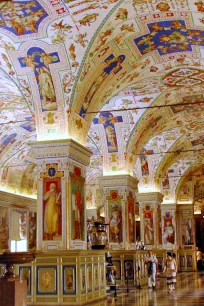
The Vatican Library (Biblioteca Apostolica Vaticana) was founded by Pope Nicholas V in 1450, when it contained about 340 books. Today it is one of the world’s most important libraries with more than half a million books and over 60,000 manuscripts. Some of the most valuable pieces are displayed in the Sistine Hall (Salone Sistino), a magnificent vaulted hall built in 1588 by Domenico Fontana. The eighty-meter-long and fifteen-meter-wide hall (appr. 260 x 50 ft.) is magnificently decorated with colorful wall and ceiling paintings.
The library also houses a number of museums, including the Profane Museum (Museo Profano) and the Sacred Museum (Museo Sacro). The latter holds a number of ancient Christian objects found in Roman catacombs as well as medieval glassware and objects made from precious materials such as ivory and enamel.
Vatican Historical Museum
The Vatican Historical Museum (Museo Storico) provides a fascinating look at the long and sometimes turbulent history of the Vatican. The museum was founded in 1973 at the request of Pope Paul VI. It was originally located near the Vatican Pinacoteca but in 1991 it moved to the Lateran Palace near the rear entrance of the basilica of St. John Lateran. The museum contains a collection of arms, armor and uniforms of the Papal armed forces as well as portraits of popes and the so-called popemobiles, the carriages and cars used by the popes.
There are plans to move the collection back to the Vatican. In the meantime the museum can only be visited by booking a guided group tour.
Other collections
Other collections of the Vatican Museums include ceramics from the eighteenth and nineteenth centuries and miniature mosaics that were very popular as a souvenir, particularly in the nineteenth century.
The Vatican Museum complex
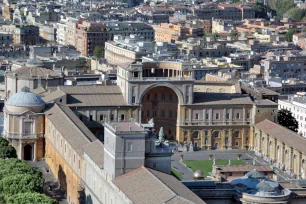
Part of the allure of a visit to the Vatican Museums is the chance to admire the lavish palace complex that houses the museums. The complex was built between the twelfth and nineteenth centuries and served as the main residence of many popes. Several rooms, including the Sistine Chapel, are occasionally still used by the papacy.
Today the pope is mostly a spiritual figure but before the unification of Italy the pope was also the head of a large worldly realm and the Vatican complex reflected their importance as heads of state. The popes hired the world’s most renowned architects and artists to decorate their residences, and these decorations, in particular the wall paintings in the private papal apartments, are worth a visit on their own.
The Courtyards and Galleries
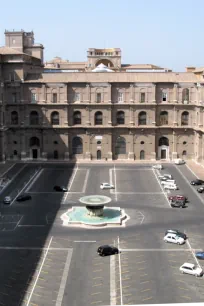
The buildings that accommodate the Vatican Museums’ collection comprise of two palaces. To the north is the Belvedere Palace, built in the late fifteenth century as the Villa Belvedere. To the south, adjoining the St. Peter’s Basilica is the Apostolic Palace, which has served as the main residence of the popes since their return from Avignon in 1377. The current palace was built in the mid-fifteenth century and replaced an older building from the fifth century.
In the early sixteenth century Bramante connected the two palaces to each other with the construction of two long wings that enclosed a large courtyard, the Cortile del Belvedere. In 1585-1590 a new wing for the library divided the courtyard in two. The lower courtyard is still known as the Cortile del Belvedere while to upper courtyard is known as the Cortile della Pigna (Pine cone Courtyard). The addition of the New Wing (Braccio Nuovo) in 1820 created another, smaller, courtyard in the middle: the Cortile della Biblioteca (Library Courtyard).
Pine Cone Courtyard
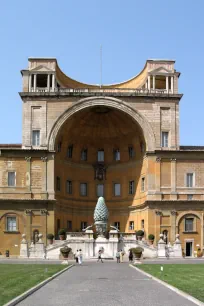
The Library Courtyard and Belvedere Courtyard are not accessible but almost any visitor to the Vatican Museums will get to visit the beautiful Pine cone Courtyard. The courtyard is named after the huge bronze pine cone that is installed in a large exedra built by Pirro Ligorio.
The pine cone is an ancient fountain that was discovered near the Pantheon and probably belonged to a temple dedicated to Isis. Water used to flow out of the scales. The two bronze peacocks that flank the pine cone are replicas of ancient sculptures that were found in the Mausoleum of Hadrian. The originals are now in the New Wing.
In the middle of the courtyard is a modern bronze sculpture, named ‘sphere within a sphere’. It is a creation of Arnaldo Pomodoro that was placed here in the 1990s.
Galleries
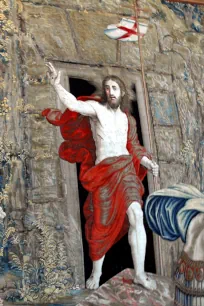
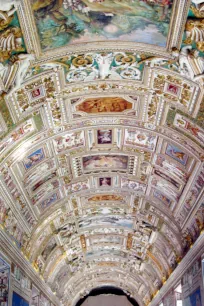
The two long wings that connect the Apostolic Palace with the Belvedere Palace are each about three hundred meters long (close to 1000ft). The east wing houses the aforementioned Chiaramonti Museum, crammed with statuary from the antiquity, and the Lapidary gallery, which is unfortunately not accessible to the public. The west wing is home to three more galleries. The first coming from the Belvedere Palace is the Candelabras Gallery (Galleria dei Candelabri), an eighty meter long (262ft) room with Greek and Roman sculptures. This room leads to the Tapestry Gallery (Galleria degli Arazzi), with tapestries from the fifth to the seventeenth centuries.
The final and longest gallery (175 m. / 600 ft.) is the Gallery of Maps (Galleria delle Carte Geografiche). The walls of this gallery are decorated with large paintings of maps created by Antoni Danti between 1580 and 1583. His brother Egnazio Dante, an architect and cosmographer, provided the necessary information. The maps show Italian cities, islands in the Mediterranean Sea and papal territories. Ceiling frescoes depict events that took place in these locations.
Rooms of the Apostolic Palace
The Renaissance popes commissioned the most talented artists of the era to lavishly decorate their palatial residences. Many of the rooms, including the Borgia Apartments and the Raphael Rooms are open to the public and included in the itinerary of the Vatican Museums.
Borgia Apartments
The Borgia Apartments (Appartamento Borgia) are a series of rooms that were converted into private apartments for Pope Alexander VI, Rodrigo de Borgia. The pope was a patron of the arts and he called upon Pinturiccio to decorate the rooms with magnificent frescoes. Between 1492 and 1495 Pinturiccio and his pupils painted six of the Borgia rooms. The frescoes depict religious themes (such as the martyrdom of saints and the mysteries of faith) and medieval themes (Trivium and Quadrivium). Most of the rooms are currently used to display a selection of the collection of modern religious art.
Chapel of Nicholas V
Often skipped by visitors on their way to the Sistine Chapel but certainly worth a visit is the intimate Chapel of Nicholas V (Cappella di Niccolo V), decorated with wonderful frescoes painted by Fra’ Angelico between 1447 and 1449. The frescoes depict scenes in the lives of saints Stephen and Lawrence.
Raphael Rooms
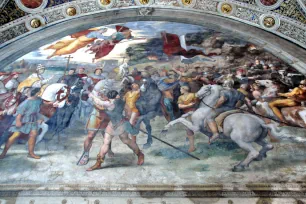
The Raphael Rooms (Stanze di Raffaelo) were commissioned by Pope Julius II who preferred to distance himself from Alexander VI and thus refused to reside in the apartments created for his predecessor. He planned on inviting a variety of renowned master painters to decorate his own private apartments (situated above the Borgia apartments) but after seeing the work of the twenty-five year old painter and architect Raffaello Santi (Raphael), he decided to instead entrust the work to him.
From 1508 on Raphael worked on and off on the decoration of the apartments, often distracted by his other work including the construction of the St. Peter’s Basilica. Raphael died in 1520, before the frescoes of the papal apartments were complete but his assistants finished the work following his designs. The frescoes are considered absolute masterpieces of Renaissance art.
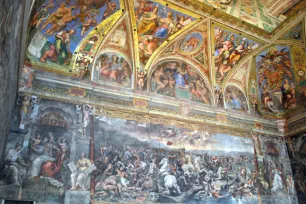
The first room is the Constantine Hall (Sala di Constantino), which was painted after Raphael had died by his assistants Giulio Romano and Francesco Penni. It shows scenes from the life of the Roman Emperor Constantine – who made Christianity the official religion – and the triumph of Christianity over Paganism. The ‘Battle of the Milvian Bridge‘ depicts the battle between Constantine and Maxentius, during which the outnumbered army of Constantine crushed the army of Emperor Maxentius by pushing the soldiers into the river.
The next room is the Room of Heliodorus (Stanza di Eliodoro), partly carried out by Raphael between 1512 and 1514. The theme of the room is the divine intervention protecting the church and saints. The room is named after one of the paintings, the ‘Expulsion of Heliodorus’, which depicts a scene from the bible. On the left are figures depicting Pope Julius II, Raphael himself and his pupil Giulio Romano. By the time Raphael painted ‘Leo the Great meeting Attila’ Julius II had passed away, and as a result his successor Leo X is portrayed twice in this fresco: Raphael initially painted him as a cardinal accompanying Leo I but later Leo X asked one of Raphael’s pupils to portray himself as Leo I.
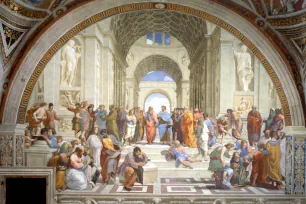
The Room of the Segnatura (Stanza della Segnatura) is named after a special committee that gathered here. Raphael started with this room in 1508 and it is the only room that was completely painted by the master himself. The subject is the harmony between the values of the antiquity and Christianity. It is best known for the ‘School of Athens‘, the most famous fresco painting in the Raphael Rooms. It is particularly acclaimed for its masterful use of perspective. The painting depicts a debate between Plato and Aristotle, two famous Greek philosophers. Many other famous figures from the antiquity are shown, including Euclid, Socrates, Pythagoras and Archimedes. Raphael inserted the portrait of many contemporary figures in the painting. Among them his friend Bramante, the Pope Julius II, Leonardo da Vinci and even his rival Michelangelo, who at the time was painting the ceiling of the Sistine Chapel.
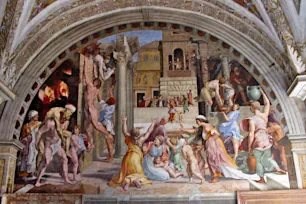
The last of the four rooms is the Room of the Fire (Stanza dell’Incendio), named after one of the frescoes. The room was decorated in 1514-1517 (mostly by Raphael’s assistants) during the pontificate of Leo X. He chose the lives of his namesakes Leo III and Leo IV as the theme for the room. The most important fresco is the Fire in the Borgo, which was painted after a sketch created by Raphael. It shows Leo IV extinguishing a fire by making the sign of a cross. The painting draws parallels with scenes from the antiquity by showing Aeneas on the left who carries his father Anchises on his back out of the burning city of Troy.
Loggia of Raphael
The Room of Constantine is connected to the Loggia of Raphael, another masterpiece of the artist. Unfortunately the loggia is only accessible by appointment. The loggia is decorated with twelve frescoes that illustrate events from the bible.
Sistine Chapel
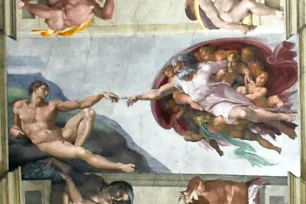
The most famous attraction in the Vatican Museums is undoubtedly the Sistine Chapel. The chapel was built in the fifteenth century as a private chapel for Pope Sixtus IV. In 1508 Pope Julius II asked Michelangelo to repaint the ceiling. Michelangelo, who didn’t see himself as a painter, only reluctantly accepted the commission.
Michelangelo decided to decorate the ceiling with nine scenes from the Old Testament. The most famous is the ‘Creation of Adam‘, which shows god descending from heaven to bring Adam to life. The walls of the chapel are also completely covered with paintings. The most famous of these is The Last Judgment on the altar wall, from the same artist.
Staircase
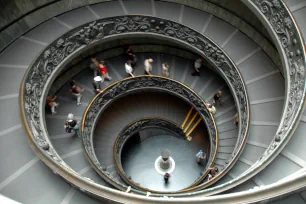
Before exiting the museum you have the chance to admire one of the world’s most famous staircases.
Designed in 1932 by Giuseppe Momo, the staircase consists of a double helix, one leading up and one leading down. The beautiful bronze staircase is decorated with the papal coats of arms.
- Next: Trevi Fountain
- More Sights & Attractions in Rome
- Related articles:

